


Thaddeus Lowe and his Civil War Observation Balloon
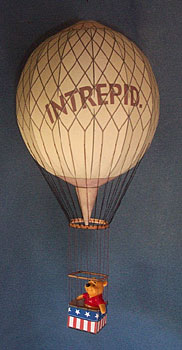
Shortly after the opening of the hostilities between the North and
the South, TSC Lowe joined the Union forces as the first military
balloon observer in the United States. Lowe first used his balloon
, "Great Western", in which he had been making exhibition flights.
He accompanied the army of General Mc Clellan, reconnoitering on
the enemy's position and aiding the artillery in directing its fire.
Lowe later became one of the country's most outstanding astronomers and
was head of Lowe's Observatory in California. This is a model of
the Civil War Observation Balloon named "Intrepid" .
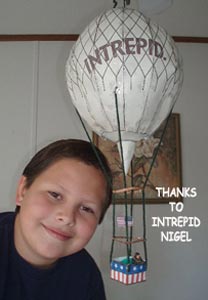
I chose the model because I like old fashion
things and I recently discovered that you have to bend the
ends of the balloon pieces that you cut out to get them
to go just right.
So I thought, "why not get this balloon and try it out". Obviously I used less than 26 strings because if I used more, you wouldn't be able to see the details on the balloon.
I don't know about Civil War aviation, but would be interesting
in learning about it. I would enjoy it if you could put
some more world war one models on the site as well as early
flying machines because I enjoy old fashion flight. I'm
almost complete on building the sopwith tripe.
I wonder why there is a hole in the bottom piece when it
isn't functional, it is covered by the pointy piece. -Nigel
That balloon, Nigel, was filled with Hydrogen (H2) and that pointy thing was the tie-off for the long tube that transported the hydrogen from the generator to the balloon. Click "More Information" above and I think you'll see a drawing of the entire apparatus.chip
Balloons go to war:
Though huge balloons continued to be made, and to fly, in Europe,
in the United, States balloonists had sterner duties to carry out.
The outbreak of the Civil War meant that the unrivaled views of
the ground provided by balloons became a vital military asset. At
the very beginning of the ballooning age, the army of Revolutionary
France had formed a balloon corps, which used hydrogen balloons
to allow observers to spot enemy movements. At the battle of Fleurus
on 26 June 1794, General Morlot stayed aloft for ten hours, watching
the maneuvers of the Austrian Army. Written messages were hauled
up and down the balloon cable, so that he could direct his own forces,
and the result was a decisive French victory.
Battle of Fleurus, where the French won a decisive In the USA, when
fighting broke out between the North and the South, most balloonists
signed up with the Austrians in 1794, thanks to the first use of
an balloon the Union Army. Unfortunately, their early efforts were
blighted by the stresses and strains of operating captive balloons
in the field, especially when these had to be inflated from a gas
main and then towed around the countryside in a fully inflated condition.
 John Wise constructed a special balloon for army service with an
iron bottom to the gondola to keep bullets at bay. It was also loaded
with rifles, rations, ammunition, and grenades to rain down on enemy
positions, but, when it was being towed across a bridge over the
Potomac, it was seized by a gust of wind and torn from the hands
of the balloon party. It floated away with its precious cargo toward
Confederate territory, and, to prevent its cargo falling into enemy
hands, they managed to shoot it down over Arlington.
John Wise constructed a special balloon for army service with an
iron bottom to the gondola to keep bullets at bay. It was also loaded
with rifles, rations, ammunition, and grenades to rain down on enemy
positions, but, when it was being towed across a bridge over the
Potomac, it was seized by a gust of wind and torn from the hands
of the balloon party. It floated away with its precious cargo toward
Confederate territory, and, to prevent its cargo falling into enemy
hands, they managed to shoot it down over Arlington.
Wise's colleague, John La Mountain, was more successful. He and
his balloon were sent by ship to Fort Monroe in southeastern
Virginia in July 1861, and, on his first ascent from the fort at
the end of that month, he was able to report the presence of two
Confederate encampments. A week later, he took his balloon on the
armed transport Fanny on a sortie up the James River. He made a
series of observation flights with his balloon tethered by cable
to the deck of the ship, making it the world's first aircraft carrier.
Later, he made other flights from the deck of the tug Adriatic so
that these two small craft formed the world's first carrier task
force. But these observation balloons were limited in the extent
of their view by their fixed positions. So La Mountain's greatest
feat was to use his old Atlantic balloon to make free flights over
enemy territory.
When the wind at ground level blew from the west,
he would ascend and drift over the Confederate lines to observe
what the enemy was doing. When he had seen all he wanted to, he
would jettison ballast from the gondola, so that the balloon rose
to higher altitudes, where the airstream usually blew from the east,
carrying him back to his own side. It was an exceedingly courageous
act, and he made a series of flights without being hit by Confederate
fire. In all that time, the nearest he came to disaster was from
a Northern unit, which did not know about his reconnaissance flights.
Seeing his balloon approach from the east, they took it for a Confederate
observer who had broken away from his mooring, and opened fire.
He managed to land without a scratch, but within six months his
career was over-having fallen out with Thaddeus Lowe, who had the
ear of the president.
The Hydrogen Balloon Intrepid
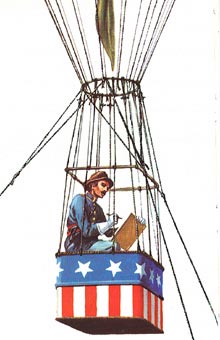 This is Lowe in the intrepid observation balloon |
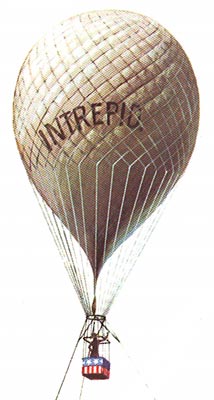 |
When the nineteenth century dawned, John Wise was the dominating
figure in American ballooning circles; he will be remembered chiefly
for his scheme to cross the Atlantic in a balloon. His only equal in the New World at that time
was his constant rival, Thaddeus S. C. Lowe, who was twenty-five
years younger. Lowe made his first balloon ascent on 17 July 1858
and, like Wise, soon became obsessed with the notion of crossing
the Atlantic in a balloon and lost no time in endeavoring to carry
out this plan.
By 1859 he had raised sufficient money in New York to enable him to proceed with the building of a very large balloon, first named City of New York and later Great Western. It was of no less than 724,000 cu.ft capacity, with a diameter of 104 ft, and was more than 200 ft tall. It was thus the largest balloon built up to that time. As Wise had planned to do with his balloon Atlantic, Lowe also carried a lifeboat below the enclosed gondola.
The first disappointing obstacle that Lowe encountered was the
inability of the gasworks in New York to fill his balloon, due
to lack of facilities to produce the required quantity of gas.
However, this was remedied when the president of the Point Breeze
gasworks in Philadelphia came to the rescue with an assurance
of being able to meet Lowe's requirements. The balloon was accordingly
transferred to Philadelphia, but had to be stored there first
for the duration of the winter. Finally, on 28 June 1860, the
balloon was ready for its first trial ascent.
By a coincidence this was the very same day that Great Eastern, then the world's largest steamer, turned up in the harbor of New York after her maiden voyage across the Atlantic Ocean. The balloon fulfilled all expectations, and every effort was aimed at enabling a start for Europe to be made in September of that year. During the filling of Great Western on 7 September a strong gust of wind caused the balloon to collide with an obstacle and be badly damaged. A second filling began on 29 September, but this time the balloon exploded due to a weakness resulting from the first mishap. After this, there was no more money left to spend on the project.
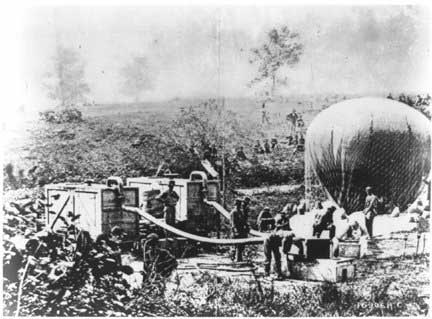 Hydrogen was made by dropping iron filings into containers of sulfuric acid then piped to the inflating balloon. This could take a couple days to complete. |
Professor Joseph Henry, a recognized scientist of the Smithsonian
Institution in Washington, D.C., who had also acted as adviser
to Wise, suggested now that Lowe also should make a long cross-country
balloon trip before he attempted again to cross the Atlantic by
air. Lowe followed this advice and left immediately for Cincinnati
with his balloon Enterprise of 20,130 cu.ft which he used for
exhibition purposes. After waiting some time for fair weather
he finally set out in April 1861 on a long trip across Virginia
and, when finally landing in South Carolina, he had covered a
distance of some 620 miles.
Unexpected strong winds blowing from
the north had forced him down at Pea Ridge near the town of Unionville
(now Union). During Lowe's balloon ascent the Civil War between
the Northern and Confederate States had started, and he was imprisoned
as a suspected Yankee spy, but soon released again after satisfying
the suspicious Southerners that his balloon trip had served scientific
purposes only. His return trip proved difficult and Lowe completely
abandoned his long-distance ballooning plans to present himself
instead to President Lincoln in Washington to offer his services.
The President appointed Lowe chief of the Army's aeronautical
division, under the command of General McClellan, whose forces
had taken up their positions on the Potomac river.
Lowe's first captive balloon ascents for the Federal Army gave
no better results than those achieved by such other volunteer
balloon operators and observers as John Wise, John La Mountain,
Samuel King, and the brothers James and Ezra Allen. The reason
for this was that, with the exception of General McClellan, all
army officers failed to realize the potential value of aerial
observation in warfare. Besides having to overcome this passive
resistance on the part of the ground forces to availing themselves
of the services of the military aeronauts, the latter were confronted
with numerous other difficulties. To begin with, their balloons
were not too well adapted to active service and, after being filled
at some distant gasworks, encountered many obstacles on the long
approach to the firing lines.
In time, however, the rivalry between the competing aeronauts
was overcome, better equipment was procured and working conditions
also were improved. A better atmosphere was likewise created when
Lowe, after the battle of Bull Run on 21 July 1861, was able to
report to Washington his important observations to the effect
that the Confederate forces, after the victory they had won there,
appeared disinclined to pursue their success. That year, in June,
Lowe had for the first time conveyed his aerial observations to
the ground by electric telegraph, the wire of which was attached
to the cable holding his balloon Enterprise.
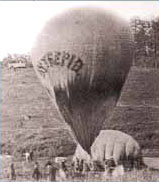 (above)The Intrepid Observation Balloon being inflated with hydrogen. (right) Portrait of a very confident Lowe |
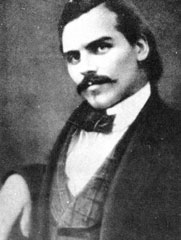 |
At the end of 1861 the Federal forces had a total of seven observation balloons at their disposal, all built by Lowe. They were named Union, Constitution, Washington, United States, Intrepid, Eagle, and Excelsior, and varied in size from 15,000 to 32,000 cu.ft. Generally they operated at an altitude of up to 5,000 ft. No attempt was made to camouflage these balloons; on the contrary, they were brightly embellished with the colors of the American flag or with the insignia of the American eagle. Lowe succeeded in developing equipment for the production of hydrogen which was suitable for transportation, and thereby provided a badly-needed mobility for the balloon units. In 1861 the converted collier G. W. Parke Custis, operating on the Potomac river, served as mother-ship of the balloon Washington.
 The balloons serving with the Federal forces unquestionably restricted
the hitherto unhampered mobility of the Confederate troops, who
tried their best to destroy them, but without much success. Twice
aerial observations saved the Federal forces from severe defeats,
during the battles of Fair Oaks and Gaines's Mill in 1862. The
Confederate attempts to establish a balloon section on their side
were few and fairly feeble.
The balloons serving with the Federal forces unquestionably restricted
the hitherto unhampered mobility of the Confederate troops, who
tried their best to destroy them, but without much success. Twice
aerial observations saved the Federal forces from severe defeats,
during the battles of Fair Oaks and Gaines's Mill in 1862. The
Confederate attempts to establish a balloon section on their side
were few and fairly feeble.
This was due to their lack of vital equipment from which the enemy blockade cut them off. Best known is the Confederate balloon that was built in Savannah at the instigation of Captain Langton Cheves.
Its envelope could hold only 7,500 cu.ft of coal gas, and because it was made up of many odd pieces, which gave it a motley appearance, it was rumored that southern belles had patriotically sacrificed their silken evening gowns for the cause.
Hence it was referred to as 'The Silk Dress Balloon', and was en route to the front on board the Confederate armed tugboat Teaser when the latter became stranded on a bar in the James river. Thus both the vessel and the balloon became an easy prey to the mobile and well-armed Federal ironclad Monitor.
The American Civil War became a testing ground for new weapons and practices, and foreign military observers, not least from Germany, carefully investigated these military developments. One such young German officer on a leave of absence, who was attached to the Federal forces for a while, was Count Ferdinand von Zeppelin, who noted the activities of Lowe and his balloon section. On an exploring trip to the sources of the Mississippi river, von Zeppelin later received his own balloon initiation with an ascent at Minneapolis.
After his return to Germany and subsequent retirement from military service, von Zeppelin was eventually to devote all his time and fortune to his idea of a rigid airship and, by sheer personal perseverance, ultimately bring forth a number of impressive Zeppelin dirigibles.
Lowe's aeronautical career turned out less successful. Neither
he nor the other civilian aeronauts were ever fully recognized
by the military professionals. Faced with a lack of sympathetic
understanding on the part of an ever-changing succession of commanding
officers, Lowe resigned in 1863 He was succeeded by the Allen
brothers, who were even less able to assert themselves, and soon
the balloon section was dissolved completely. Thereafter the U.S.
Army possessed no balloons for the next thirty years!
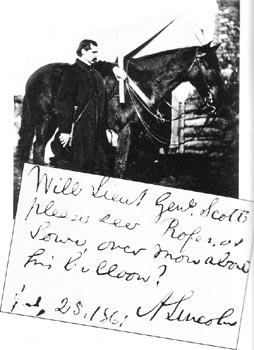 Note from Abe Lincoln asking for Lowe's balloon services."Will Lieut. Genl. Scott please see Professor Lowe once more about his balloon?" wrote President Lincoln in July 1861. Scott refused, until Lincoln personally escorted Lowe to Army headquarters. Later, armed with a spyglass (top), Lowe went off to scout the Confederates. |
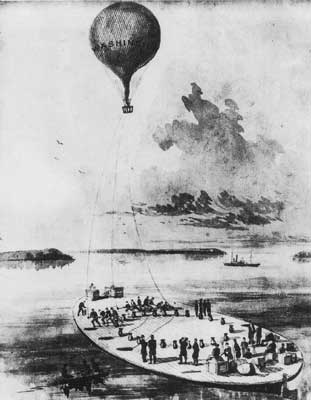 The old steamer George Washington Parke Custis becomes a mobile launching site for Lowe's ascents along the Potomac. The ship's likeness to the Union's ironclad Monitor was a deterrent to enemy attack, Lowe wrote, "for the Monitor was what the Confederates dreaded. " |
Lowe observing the fighting from his observation balloon |
|
The United States that was rocked by the outbreak of civil war in April of 1861 was a nation infatuated with balloon flight. The exploits of such balloonists as John Wise, John LaMountain and Thaddeus Lowe had been front-page news for years. Reporters had written breathtaking accounts of the ordeal endured by Wise and LaMountain in their storm hounded voyage across Lake Ontario in 1859; LaMountain had made the headlines again in that year when he suffered through four days in the Canadian wilderness after his balloon went astray.
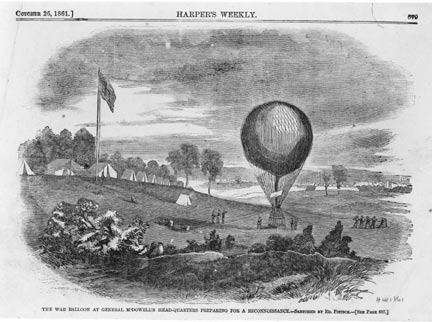
Thaddeus Sobieski Constantine Lowe, part showman and part serious balloonist, combined a talent for promotion with his aeronautical skills. Born in New Hampshire in 1832, Lowe exhibited a boyhood curiosity about aeronautics, sometimes using kites to send aloft the family cat. By 1854, having worked for a time as an assistant to a traveling magician, Lowe had decided on a career in ballooning.
After four years of study he built his first balloon; he soon gained a reputation as an accomplished aeronaut. His well-trumpeted plan to cross the Atlantic by balloon, though it failed, made him a national figure. And his unplanned touchdown in the heart of secessionist South Carolina on a pre-Atlantic test flight in the spring of 1861 left him thinking about how balloons might serve the Union in the growing conflict between North and South.
Balloons had never been deployed by an American army, though their use had been suggested-and spurned-at least twice before. In 1840, after United States troops had tried in vain for five years to put down the rebellious Seminole Indians of Florida, an imaginative Army colonel suggested that balloon reconnaissance could help locate hidden enemy encampments. Two years later, when the Florida Indian wars finally drew to a close, the aerial- observation scheme was still tied down by military red tape.
Not long after the outbreak of the Mexican War in 1846, John Wise had come up with his own proposal for military aeronautics. Wise's widely publicized plan called for the bombardment from a manned balloon of the powerful fortress of San Juan de U16a in the strategic Mexican port city of Veracruz. One commentator noted that it would be a "very troublesome matter to enlist the volunteers" to lob bombshells from Wise's proposed altitude of 5,000 feet. The proposal failed to get the endorsement of the U.S. War Department.
By the time of the Civil War, the high command was generally more receptive to the idea of aeronautics. Nevertheless, the Union Army's balloon operations got off to a chaotic start. The patriotic aeronauts who rushed to volunteer as balloon observers had to make their own arrangements with individual officers; unlike the 18th Century French aerostiers, the American military balloonists retained their civilian status. Their equipment, for the most part, was not well suited to the stresses of tethered flight, and most of the officers and soldiers with whom they served lacked even the most elemental understanding of the special requirements and frailties of balloons.
In June and July 1861, with Confederate troops massing at Bull Run, southwest of Washington, no fewer than four balloonists were seeking acceptance as Union aeronauts. James Allen, attached to the Rhode Island regiment led by Colonel Ambrose Burnside, performed a successful demonstration flight in the capital, but then saw his hopes for action dashed when his inflated balloon was destroyed in an encounter with a telegraph pole while en route to the front.
John LaMountain, who had offered his services at the outbreak of hostilities only to be ignored, was then summoned to conduct aerial observations at Fortress Monroe, a key Union outpost near the mouth of the James River in Virginia. The 53-year-old John Wise, who had first volunteered for front-line combat duty, was ordered to build a balloon and bring it to Washington, where he was quickly mired in the bureaucratic turmoil that beset the wartime capital.
Only the adroit Thaddeus Lowe was able to thread his way successfully through the administrative minefields of Washington, and even he had his share of problems. Lowe's acquaintance with Secretary Joseph Henry of the Smithsonian Institution and the warm support of Treasury Secretary Salmon Chase landed him a meeting with Abraham Lincoln. The President listened with interest as Lowe outlined a plan for a corps of balloonists who would communicate with the ground by telegraph.
The War Department promptly authorized funds to enable Lowe to make a trial ascent from the mall between the Capitol and the unfinished Washington Monument in a balloon named, like the original French war balloon of the 1790s, Enterprise. On June 18, 1861, Lowe and two representatives of the telegraph company rose to an altitude of about 500 feet, from which point they could see for nearly 25 miles in every direction. Lowe dictated a message to President Lincoln: "The city with its girdle of encampments presents a superb scene," he said. "I have pleasure in sending you this first dispatch ever telegraphed from an aerial station."
|
|



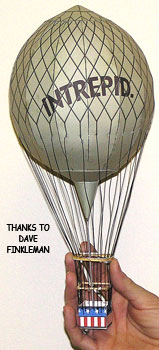 Chip,
Chip,